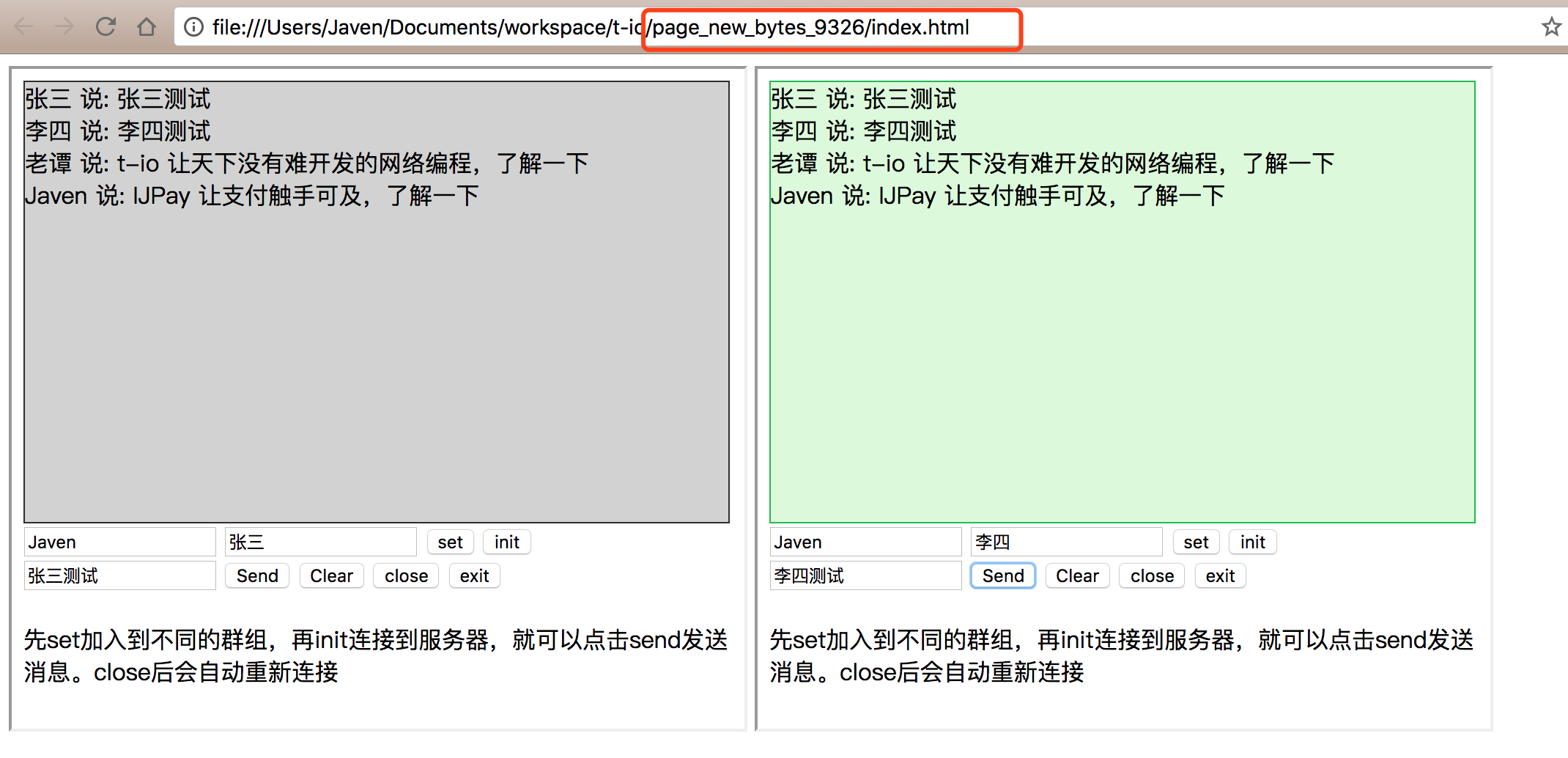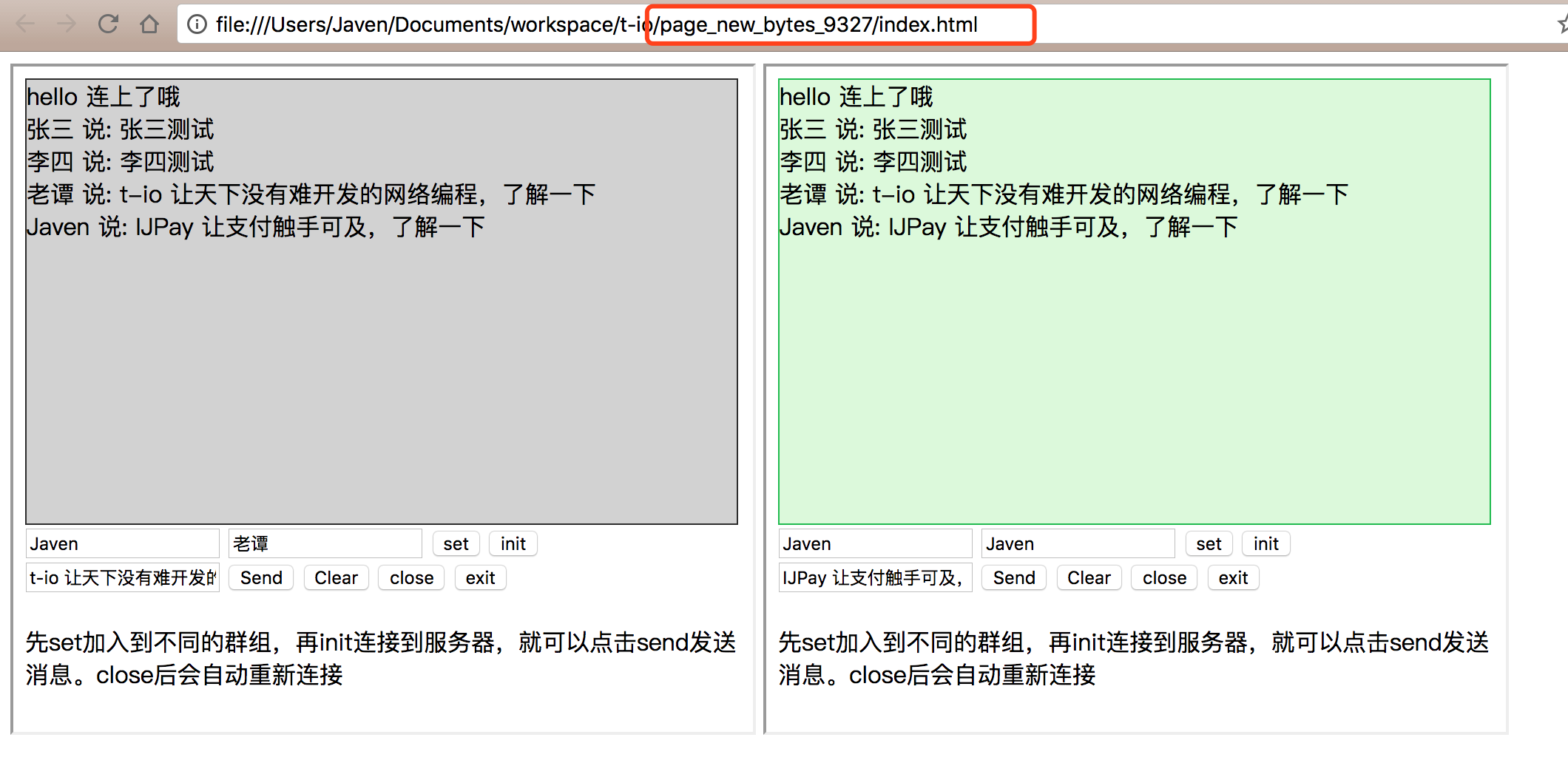本博客是基于老谭t-io showcase中的tio-websocket-showcase 示例来实现集群。看showcase 入门还是挺容易的,入坑(入门)请看老谭写的用t-io来写一个网页聊天室或客服是个怎样的体验。 要深入理解具体实现原理后续的业务扩展,把t-io玩6起来还需要耐心看看源码,看了之后我相信你一定会有收获的,祝你好运。
其实t-io 在2.4的版本中已加入的集群实现的逻辑代码,只是官方没有写文档以及完整的示例而已,在此不得不说t-io 是一个比较良心的开源项目,很多业务场景都有考虑到。你们有需求也可以去t-io提issues。
实现思路就是基于redis来做一个发布/订阅的方式达到多节点协作的目的,t-io内置的集群也是使用的此解决方案。下面就来聊聊如何使用t-io的内置集群。
在t-io中是否开启集群是通过org.tio.core.GroupContext中的tioClusterConfig是否为空来判断的。
好了,闲话少说直接上菜(代码)
判断是否开启集群(org.tio.core.GroupContext)
/**
* 是否是集群
* @return true: 是集群
* @author: tanyaowu
*/
public boolean isCluster() {
return tioClusterConfig != null;
}tio-websocket-showcase中增加集群解决方案
//实例化t-io集群配置
TioClusterConfig tioClusterConfig = TioClusterConfig.newInstance("Javen", RedissonTemplate.me().getRedissonClient());
//开启群组集群-默认不集群
tioClusterConfig.setCluster4group(true);
//配置t-io集群
serverGroupContext.setTioClusterConfig(tioClusterConfig);J-IM中的部分代码,目的是来实例化RedissonClientRedissonTemplate 代码如下慢慢品读
package org.jim.common.cache.redis;
import java.io.Serializable;
import org.redisson.Redisson;
import org.redisson.api.RedissonClient;
import org.redisson.config.Config;
import org.redisson.config.SingleServerConfig;
import org.slf4j.Logger;
import org.slf4j.LoggerFactory;
/**
* @author WChao
* @date 2018年5月18日 下午2:46:55
*/
public class RedissonTemplate implements Serializable{
private static final long serialVersionUID = -4528751601700736437L;
private static final Logger logger = LoggerFactory.getLogger(RedissonTemplate.class);
private static RedissonTemplate instance = null;
private static RedisConfiguration redisConfig = null;
private static final String REDIS = "redis";
private static RedissonClient redissonClient = null;
private RedissonTemplate(){};
public static RedissonTemplate me() throws Exception{
if (instance == null) {
synchronized (RedissonTemplate.class) {
if(instance == null){
redisConfig = RedisConfigurationFactory.parseConfiguration();
init();
instance = new RedissonTemplate();
}
}
}
return instance;
}
private static final void init() throws Exception {
String host = redisConfig.getHost();
if(host == null) {
logger.error("the server ip of redis must be not null!");
throw new Exception("the server ip of redis must be not null!");
}
int port = redisConfig.getPort();
String password = redisConfig.getAuth();
Config redissonConfig = new Config();
SingleServerConfig singleServerConfig = redissonConfig.useSingleServer();
singleServerConfig.setAddress(REDIS+"://"+host+":"+port).setPassword(password).setTimeout(redisConfig.getTimeout()).setRetryAttempts(redisConfig.getRetryNum());
try {
redissonClient = Redisson.create(redissonConfig);
} catch (Exception e) {
logger.error("cann't create RedissonClient for server"+redisConfig.getHost());
throw new Exception("cann't create RedissonClient for server"+redisConfig.getHost());
}
}
/**
* 获取RedissonClient客户端;
* @return
*/
public final RedissonClient getRedissonClient(){
return redissonClient;
}
}看到这里有人可能要问,在什么地方发布消息以及处理订阅消息!!!
什么地方发布消息
当然是发送消息的时候,调用Tio.sendXxx()系列方法的时候。在tio-websocket-showcase中主要实现的是群聊,调用的是Tio.sendToGroup(),具体实现代码如下:
/**
* 发消息到组
* @param groupContext
* @param group
* @param packet
* @param channelContextFilter
* @author tanyaowu
*/
private static Boolean sendToGroup(GroupContext groupContext, String group, Packet packet, ChannelContextFilter channelContextFilter, boolean isBlock) {
try {
SetWithLock<ChannelContext> setWithLock = groupContext.groups.clients(groupContext, group);
if (setWithLock == null) {
log.debug("{}, 组[{}]不存在", groupContext.getName(), group);
return false;
}
Boolean ret = sendToSet(groupContext, setWithLock, packet, channelContextFilter, isBlock);
return ret;
} finally {
//判断是否集群以及是不是集群通过topic转过来的消息包
if (groupContext.isCluster() && !packet.isFromCluster()) {
TioClusterConfig tioClusterConfig = groupContext.getTioClusterConfig();
//判断是否开启了群组集群
if (tioClusterConfig.isCluster4group()) {
// TioClusterVo tioClusterVo = new TioClusterVo(packet);
// tioClusterVo.setGroup(group);
// tioClusterConfig.publishAsyn(tioClusterVo);
//在集群环境下,把群组消息通知到集群中的其它机器
notifyClusterForGroup(groupContext, group, packet);
}
}
}
}/**
* 在集群环境下,把群组消息通知到集群中的其它机器
* @param groupContext
* @param group
* @param packet
*/
public static void notifyClusterForGroup(GroupContext groupContext, String group, Packet packet) {
TioClusterConfig tioClusterConfig = groupContext.getTioClusterConfig();
TioClusterVo tioClusterVo = new TioClusterVo(packet);
tioClusterVo.setGroup(group);
tioClusterConfig.publishAsyn(tioClusterVo);
}处理订阅消息
其实在t-io中有默认实现,具体的代码如下
public void setTioClusterConfig(TioClusterConfig tioClusterConfig) {
this.tioClusterConfig = tioClusterConfig;
if (this.tioClusterConfig != null) {
this.tioClusterConfig.addMessageListener(new DefaultMessageListener(this));
}
}org.tio.core.cluster.DefaultMessageListener 有详细的注释慢慢品读
package org.tio.core.cluster;
import org.apache.commons.lang3.StringUtils;
import org.redisson.api.listener.MessageListener;
import org.slf4j.Logger;
import org.slf4j.LoggerFactory;
import org.tio.core.Tio;
import org.tio.core.GroupContext;
import org.tio.core.intf.Packet;
import org.tio.utils.json.Json;
import java.util.Objects;
import java.util.concurrent.atomic.AtomicLong;
/**
* 默认的集群消息监听类
* 作者: 陈磊(Cooppor)
* 日期: 2018-05-28 15:08
*/
public class DefaultMessageListener implements MessageListener<TioClusterVo> {
private static Logger log = LoggerFactory.getLogger(DefaultMessageListener.class);
/**
* 收到了多少次topic
*/
private static final AtomicLong RECEIVED_TOPIC_COUNT = new AtomicLong();
private GroupContext groupContext;
public DefaultMessageListener(GroupContext groupContext) {
this.groupContext = groupContext;
}
@Override
public void onMessage(String channel, TioClusterVo tioClusterVo) {
log.info("收到topic:{}, count:{}, tioClusterVo:{}", channel, RECEIVED_TOPIC_COUNT.incrementAndGet(), Json.toJson(tioClusterVo));
String clientid = tioClusterVo.getClientId();
if (StringUtils.isBlank(clientid)) {
log.error("clientid is null");
return;
}
if (Objects.equals(TioClusterVo.CLIENTID, clientid)) {
log.info("自己发布的消息,忽略掉,{}", clientid);
return;
}
Packet packet = tioClusterVo.getPacket();
if (packet == null) {
log.error("packet is null");
return;
}
packet.setFromCluster(true);
//发送给所有
boolean isToAll = tioClusterVo.isToAll();
if (isToAll) {
Tio.sendToAll(groupContext, packet);
}
//发送给指定组
String group = tioClusterVo.getGroup();
if (StringUtils.isNotBlank(group)) {
Tio.sendToGroup(groupContext, group, packet);
}
//发送给指定用户
String userid = tioClusterVo.getUserid();
if (StringUtils.isNotBlank(userid)) {
Tio.sendToUser(groupContext, userid, packet);
}
//发送给指定token
String token = tioClusterVo.getToken();
if (StringUtils.isNotBlank(token)) {
Tio.sendToToken(groupContext, token, packet);
}
//发送给指定ip
String ip = tioClusterVo.getIp();
if (StringUtils.isNotBlank(ip)) {
Tio.sendToIp(groupContext, ip, packet);
}
//发送给指定channelId
String channelId = tioClusterVo.getChannelId();
if (StringUtils.isNotBlank(channelId)) {
Tio.sendToId(groupContext, channelId, packet);
}
}
}哥们,测试时别忘了配置Redis。
/tio-websocket-showcase/src/main/resources/redis.properties
#连接池连接不够用时,重试获取连接次数
retrynum = 100
#可用连接实例的最大数目,默认值为8;
maxactive = -1
#控制一个pool最多有多少个状态为idle(空闲的)的jedis实例,默认值也是8。
maxidle = 20
#等待可用连接的最大时间,单位毫秒,默认值为-1,表示永不超时。
maxwait = 5000
timeout = 2000
#redis所在机器ip
host = 127.0.0.1
#redis端口号
port = 6379
#redis密码
auth = 开启两个端口测试
9326以及9327


到这里在t-io 中借助Redis来实现集群部署实现步骤就介绍完了,个人能力有限如有错误欢迎指正。你有更好的解决方案或者建议欢迎一起交流讨论,如有疑问欢迎留言。
Fork的源码地址 https://gitee.com/javen205/tio-websocket-showcase
原文:https://www.cnblogs.com/zyw-205520/p/9549561.html